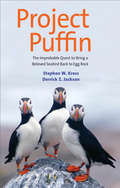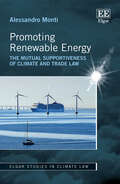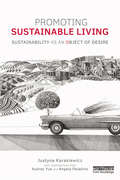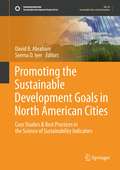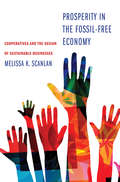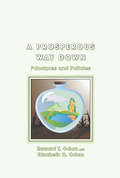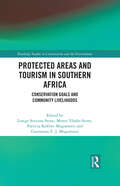- Table View
- List View
Project Puffin: The Improbable Quest to Bring a Beloved Seabird Back to Egg Rock (A\national Audubon Society Book)
by Stephen W. Kress Derrick Z. JacksonProject Puffin is the inspiringstory of how a beloved seabird was restored to long-abandoned nesting colonies off the Maine coast. As a young ornithology instructor at the Hog Island Audubon Camp, Dr. Stephen W. Kress learned that puffins had nested on nearby islands until extirpated by hunters in the late 1800s. To right this environmental wrong, he resolved to bring puffins back to one such island—Eastern Egg Rock. Yet bringing the plan to reality meant convincing skeptics, finding resources, and inventing restoration methods at a time when many believed in “letting nature take its course.” Today, Project Puffin has restored more than 1,000 puffin pairs to three Maine islands. But even more exciting, techniques developed during the project have helped to restore rare and endangered seabirds worldwide. Further, reestablished puffins now serve as a window into the effects of climate change. The success of Dr. Kress's project offers hope that people can restore lost wildlife populations and the habitats that support them. The need for such inspiration has never been greater.
Project X CODE Extra: Green Book Band, Oxford Level 5: Jungle Trail: Big in the Jungle
by Kate ScottProject X CODE Extra introduces more exciting adventure stories and stimulating non-fiction texts into the Project X CODE series, to provide additional practice outside of the core intervention sessions. Come on a BIG jungle adventure in this Jungle Trail non-fiction book.
Project X Origins: Dark Red Book Band, Oxford Level 17 Extreme: Survival Handbook
by Claire LlewellynIn Survival Handbook discover what it takes to survive in the harshest conditions, such as the Arctic or the desert, and how to escape dangers such as quicksand or earthquakes. This book is part of Project X Origins, a ground-breaking guided reading programme for the whole school.
Projektmanagement bei der Sanierung bewohnter Altlasten: Praxisberichte der Tagung Bewohnte Altlasten II vom 21. und 22. Januar 1998 in der Kongreßhalle Gießen
by Hessisches Ministerium Hessisches Ministeri UmweltDie Sanierung bewohnter Altlasten erfordert aufgrund der engen Verzahnung mit der städtebaulichen Planung und der persönlichen Betroffenheit der Anwohner eine gute Abstimmung und ein zielorientiertes Projektmanagement. Alle beteiligten Akteure erhalten hier einen Einblick in die Problematik und die anstehenden Entscheidungsfindungsprozesse. Anhand von Fallbeispielen werden unterschiedliche Lösungsmöglichkeiten diskutiert. Angesprochen werden dabei u. a. auch rechtliche Fragen sowie die in jüngster Vergangenheit verstärkt eingeführten Bürgerbeteiligungen (z. B. über Projektbeiräte).
The Promise of Nostalgia: Reminiscence, Longing and Hope in Contemporary American Culture (Routledge Research in Anticipation and Futures)
by Nicola SayersThe Promise of Nostalgia analyses a range of texts – including The Virgin Suicides, both the novel by Jeffrey Eugenides’ and Sofia Coppola’s screen adaptation, photography of Detroit’s ‘abandoned spaces’, and blogger Tavi Gevinson's media output – to explore nostalgia as a prominent affect in contemporary American cultural production. Counter to the prevalent caricature of nostalgia as anti-future, the book proposes a more nuanced reading of its stakes and meanings. Instead of understanding it as evidence of the absence of utopia it contends that there is a masked utopian impulse in this nostalgia ‘mode’ and critical potential in what has typically been dismissed as ideological. This book will be of interest to scholars, graduate students and upper-level undergraduate students interested in contemporary culture, cultural theory, media studies, the Frankfurt School, utopian studies and American literature and culture.
The Promise of Nostalgia: Reminiscence, Longing and Hope in Contemporary American Culture (Routledge Research in Anticipation and Futures)
by Nicola SayersThe Promise of Nostalgia analyses a range of texts – including The Virgin Suicides, both the novel by Jeffrey Eugenides’ and Sofia Coppola’s screen adaptation, photography of Detroit’s ‘abandoned spaces’, and blogger Tavi Gevinson's media output – to explore nostalgia as a prominent affect in contemporary American cultural production. Counter to the prevalent caricature of nostalgia as anti-future, the book proposes a more nuanced reading of its stakes and meanings. Instead of understanding it as evidence of the absence of utopia it contends that there is a masked utopian impulse in this nostalgia ‘mode’ and critical potential in what has typically been dismissed as ideological. This book will be of interest to scholars, graduate students and upper-level undergraduate students interested in contemporary culture, cultural theory, media studies, the Frankfurt School, utopian studies and American literature and culture.
Promoting Renewable Energy: The Mutual Supportiveness of Climate and Trade Law (Elgar Studies in Climate Law)
This incisive book examines the interaction between international climate law and international trade law for the promotion of renewable energy. Alessandro Monti utilizes the emerging principle of mutual supportiveness to inform and guide his analysis of the specific interactions between climate and trade law in the renewable energy sector.The book makes a meaningful contribution to the literature within public international law, engaging with scholarly discourse on the fragmentation of international law and providing an in-depth analysis of the theoretical context against which the principle of mutual supportiveness is emerging. Chapters examine the WTO jurisprudence on renewable energy subsidies, propose specific solutions to improve the alignment between climate and trade law, and build a case for the development of climate-friendly trade policies. Taking account of the multifaceted interactions between international climate and trade law, Monti highlights the implications of trade disputes on renewable energy and the promotion of climate objectives.Addressing the specialized legal regimes of both climate and trade law, Promoting Renewable Energy will prove a valuable resource to students and scholars of environmental, trade, and energy law. International policy officers, legal practitioners and NGOs working on climate, trade and energy policies will also benefit from its examination of relevant legal frameworks.
Promoting Sustainable Innovation and the Circular Economy: Legal and Economic Aspects
by Ole-Andreas Rognstad, Taina Pihlajarinne and Jukka MähönenThe book explores the role of public market actors in sustainable and circular economy innovation and financing.The shift to a circular economy requires active innovation, alongside radical changes in law, finance and policy considerations, since regulation is often tightly connected with the assumption of a linear model of consumption. Finance is crucial in creating sustainable and circular economy markets and innovations: public finance is important from the perspective of seeing the state as an engine for promoting sustainable innovations, but private funds are also required. Legislative initiatives for promoting repairs have been proposed or adopted in the EU, US and in Australia, representing remarkable steps forward but still leaving many obstacles without legislative intervention. This book examines circular economy regulation and policy on a comprehensive, general level, as well as assessing the regulatory possibilities of promoting the right to repair. Promotion of circular economy innovations as well as changing the practices and changing consumer patterns towards a more comprehensive adoption of CE are discussed from perspectives of legal, social and moral norms. The book critically evaluates current legislative reforms and assesses existing barriers to the circular economy and innovation in intellectual property law, consumer law and competition law.Providing an in-depth analysis of this dynamic field, geared towards reconsidering both existing and prospective policies and regulatory regime, the book makes recommendations for solutions to legislative barriers. It is an indispensable resource for both researchers and practitioners working at the intersections of markets, innovations and sustainability.
Promoting Sustainable Innovation and the Circular Economy: Legal and Economic Aspects
The book explores the role of public market actors in sustainable and circular economy innovation and financing.The shift to a circular economy requires active innovation, alongside radical changes in law, finance and policy considerations, since regulation is often tightly connected with the assumption of a linear model of consumption. Finance is crucial in creating sustainable and circular economy markets and innovations: public finance is important from the perspective of seeing the state as an engine for promoting sustainable innovations, but private funds are also required. Legislative initiatives for promoting repairs have been proposed or adopted in the EU, US and in Australia, representing remarkable steps forward but still leaving many obstacles without legislative intervention. This book examines circular economy regulation and policy on a comprehensive, general level, as well as assessing the regulatory possibilities of promoting the right to repair. Promotion of circular economy innovations as well as changing the practices and changing consumer patterns towards a more comprehensive adoption of CE are discussed from perspectives of legal, social and moral norms. The book critically evaluates current legislative reforms and assesses existing barriers to the circular economy and innovation in intellectual property law, consumer law and competition law.Providing an in-depth analysis of this dynamic field, geared towards reconsidering both existing and prospective policies and regulatory regime, the book makes recommendations for solutions to legislative barriers. It is an indispensable resource for both researchers and practitioners working at the intersections of markets, innovations and sustainability.
Promoting Sustainable Living: Sustainability as an Object of Desire (Routledge Studies in Sustainability)
by Justyna Karakiewicz Audrey Yue Angela PaladinoCurrent images of sustainability are often designed to instil fear and force change, not because we believe in it, but because we fear the consequences of inaction. Moving away from negative portrayals of sustainability, this book identifies the factors that motivate people to aspire towards sustainable living. It introduces the notion of sustainability as an "object of desire" that will allow people not to be scared of the future but rather to dream about it and look forward to a better quality of life. Tracing the history of major changes in our society that have dramatically altered our perceptions, beliefs and attitudes about sustainability, the book analyses the role of communications in persuading people of the benefits of sustainable living. It describes our current desires and dreams and explains why we need to change. Finally, the book suggests what could be done to not only make sustainability an object of desire, but also introduce hopes and dreams for a better future into our everyday lives. This inspiring and interdisciplinary book provides innovative insights for researchers, students and professionals in a range of disciplines, in particular environment and sustainability, sustainable marketing and advertising, and psychology.
Promoting Sustainable Living: Sustainability as an Object of Desire (Routledge Studies in Sustainability)
by Justyna Karakiewicz Audrey Yue Angela PaladinoCurrent images of sustainability are often designed to instil fear and force change, not because we believe in it, but because we fear the consequences of inaction. Moving away from negative portrayals of sustainability, this book identifies the factors that motivate people to aspire towards sustainable living. It introduces the notion of sustainability as an "object of desire" that will allow people not to be scared of the future but rather to dream about it and look forward to a better quality of life. Tracing the history of major changes in our society that have dramatically altered our perceptions, beliefs and attitudes about sustainability, the book analyses the role of communications in persuading people of the benefits of sustainable living. It describes our current desires and dreams and explains why we need to change. Finally, the book suggests what could be done to not only make sustainability an object of desire, but also introduce hopes and dreams for a better future into our everyday lives. This inspiring and interdisciplinary book provides innovative insights for researchers, students and professionals in a range of disciplines, in particular environment and sustainability, sustainable marketing and advertising, and psychology.
Promoting the Sustainable Development Goals in North American Cities: Case Studies & Best Practices in the Science of Sustainability Indicators (Sustainable Development Goals Series)
by David B. Abraham Seema D. IyerThis volume presents North American best practices and perspectives on developing, managing and monitoring indicators to track development progress towards the Sustainable Development Goals (SDGs) in local communities and cities. In 4 main sections, the book presents and frames the many ways in which community indicator programs are either integrating or retooling to integrate the SDGs into their existing frameworks, or how they are developing new programs to track and report progress on the SDGs. This is the first volume that focuses on SDG adoption within the context of North Americans cities and communities, and the unique issues and opportunities prevalent in these settings. The chapters are developed by experienced academics and practitioners of community planning and sustainable development, and will add broad perspective on public policy, organizational management, information management and data visualization. This volume presents a case-study approach to chapters, offering lessons that can be used by three main audiences: 1) teachers and researchers in areas of urban, regional, and environmental planning, urban development, and public policy; 2) professional planners, decision-makers, and urban managers; and 3) sustainability activists and interested groups.
Property Rights and Climate Change: Land use under changing environmental conditions (Routledge Complex Real Property Rights Series)
by Fennie Van Straalen Thomas Hartmann John SheehanProperty Rights and Climate Change explores the multifarious relationships between different types of climate-driven environmental changes and property rights. This original contribution to the literature examines such climate changes through the lens of property rights, rather than through the lens of land use planning. The inherent assumption pursued is that the different types of environmental changes, with their particular effects and impact on land use, share common issues regarding the relation between the social construction of land via property rights and the dynamics of a changing environment. Making these common issues explicit and discussing the different approaches to them is the central objective of this book. Through examining a variety of cases from the Arctic to the Australian coast, the contributors take a transdisciplinary look at the winners and losers of climate change, discuss approaches to dealing with changing environmental conditions, and stimulate pathways for further research. This book is essential reading for lawyers, planners, property rights experts and environmentalists.
Property Rights and Climate Change: Land use under changing environmental conditions (Routledge Complex Real Property Rights Series)
by Fennie Van Straalen Thomas Hartmann John SheehanProperty Rights and Climate Change explores the multifarious relationships between different types of climate-driven environmental changes and property rights. This original contribution to the literature examines such climate changes through the lens of property rights, rather than through the lens of land use planning. The inherent assumption pursued is that the different types of environmental changes, with their particular effects and impact on land use, share common issues regarding the relation between the social construction of land via property rights and the dynamics of a changing environment. Making these common issues explicit and discussing the different approaches to them is the central objective of this book. Through examining a variety of cases from the Arctic to the Australian coast, the contributors take a transdisciplinary look at the winners and losers of climate change, discuss approaches to dealing with changing environmental conditions, and stimulate pathways for further research. This book is essential reading for lawyers, planners, property rights experts and environmentalists.
Prospects for Alternative Energy Development in the U.S. West: Tilting at Windmills? (Environmental Challenges and Solutions #8)
by John C. Pierce Brent S. SteelThis book poses the question of whether identifiable individual-level attributes (e.g., values, interests, knowledge, demographic characteristics) lead to support for or opposition to the development and implementation of alternative energy technologies. In recent years, attempts to site alternative energy technologies (e.g., wind, solar, wave) have been met by intense opposition from a variety of sources, including many environmentalists from whom one might expect support for non-carbon based renewable energy initiatives. This volume argues that there are indeed such discernible attributes, and moreover that the identification and exploration are important for the development of support strategies for the well-informed and achievable siting of such technologies.
Prospects for Saline Agriculture (Tasks for Vegetation Science #37)
by R. Ahmad K. A. MalikSaline land is a resource capable of significant production. Recent advances in research in breeding for salt tolerance in wheat, biotechnology in rice, and selection and rehabilitation of salt-tolerant plants are of economic importance in arid/saline conditions. This book gives some practical approaches for saline agriculture and afforestation, and describes examples of cultivating salt-tolerant/halophytic plants for commercial interest on salt-affected land or with highly salinized water in Australia, China, Central Asia, Egypt, Pakistan, and Russia. It also explores the possibilities of arid/saline agriculture and afforestation in UAE.
Prosperity in the Fossil-Free Economy: Cooperatives and the Design of Sustainable Businesses
by Melissa K ScanlanA blueprint for creating sustainable businesses, emphasizing the power and potential of cooperative models Drawing on both her extensive experience founding and directing social enterprises and her interviews with sustainability leaders, Melissa Scanlan provides a legal blueprint for creating alternate corporate business models that mitigate climate change, pay living wages, and act as responsible community members, including Certified B Corps and benefit corporations. With an emphasis on cooperatives, this book reveals the power and potential of cooperating as a unifying concept around which to design social enterprise achieving triple bottom-line results: for society, the environment, and finance.
A Prosperous Way Down: Principles and Policies
by Howard T. Odum Elisabeth C. OdumA Prosperous Way Down (2001), the last book by Howard T. and Elisabeth C. Odum, has shaped politics and planning as nations, states, and localities begin the search for ways to adapt to a future with vastly increased competition for energy. A Prosperous Way Down considers ways in which a future with less fossil fuel could be peaceful and prosperous. Although history records the collapse of countless civilizations, some societies and ecosystems have managed to descend in orderly stages, reducing demands and selecting and saving what is most important. The authors make recommendations for a more equitable and cooperative world society, with specific suggestions based on their evaluations of trends in global population, wealth distribution, energy sources, conservation, urban development, capitalism and international trade, information technology, and education. Available for the first time in paperback, this thoughtful, provocative book forces us to confront assumptions about our world 's future and provides both a steadying hand and a call to action with its pragmatic analysis of a global transition.
Protected Area Regulation and Tourism: Science-informed Ecological Transitions
by Valentina DinicaThis innovative book explores the evolution of ecology and how scientific advances enable the redesign of Protected Areas (PA), guided by area-specific ecological values and objectives. It argues that transitions towards science-informed integrated PA systems could contribute to safeguarding the persistence of biodiversity and socio-ecological systems.Valentina Dinica proposes a conceptual framework to integrate the ecological and tourism aspects of PA regulation, assisting decision-makers to develop contextually effective regulatory instruments that avoid over-/under-regulating tourism, given the PA’s ecological profiles. The framework is applied to comparatively evaluate the ecological representativeness and regulations of PA networks in New Zealand, Tasmania and Hawaii. The empirical chapters also discuss gaps and (mis-)alignments between ecology and tourism regulations, displaying outdated scientific paradigms. The book proposes a new approach to classifying PAs, to better balance human–nature relationships.This book will be of interest to students and academics in public policy, law, ecology, environmental studies, sustainability sciences, tourism studies, political science and history of science.
Protected Areas: A Legal Geography Approach
by Josephine GillespieThis book argues that legal geography provides new insights into contemporary conservation challenges. Despite unprecedented efforts, we are facing an extinction crisis, and in situ protected area programs are falling short. This book discusses the protected area phenomenon and calls for changes to current approaches, informed by legal geography –an inter-disciplinary area focused on the intertwined people–place–law dynamics that enable, or disable, effective management practices. The book examines two protected area types: World Heritage Sites, where places of ‘outstanding universal value’ are protected for all humanity, and Ramsar protected wetland sites, one of the first global environmental protection initiatives. Using case studies from the Australasian region (Australia, the Pacific and Southeast Asia), it reveals how current approaches can be improved by taking into account the people–place–law nexus embedded in legal geography research.
Protected Areas and Tourism in Southern Africa: Conservation Goals and Community Livelihoods (Routledge Studies in Conservation and the Environment)
by Lesego Senyana StoneThis volume discusses the complex relationship between Protected Areas and tourism and their impact on community livelihoods in a range of countries in Southern Africa. Protected areas and tourism have an enduring and symbiotic relationship. While protected areas offer a desirable setting for tourism products, tourism provides revenue that can contribute to conservation efforts. This can bring benefits to local communities, but it can also have a negative impact, with the establishment of protected areas leading to the eviction of local communities from their original places of residence, while also preventing them from accessing the natural resources they once enjoyed. Taking a multi-disciplinary approach, this book addresses the opportunities and challenges faced by communities and other stakeholders as they endeavour to achieve their conservation goals and work towards improving community livelihoods. Case studies from Botswana, Malawi, Namibia, South Africa, Tanzania, Zambia and Zimbabwe address key issues such as human–wildlife conflicts, ecotourism, wildlife-based tourism, landscape governance, wildlife crop-raiding and trophy hunting, including the high-profile case of Cecil the lion. Chapters highlight both the achievements and positive outcomes of protected areas, but also the challenges faced and their impact on how protected areas are viewed and also conservation priorities more generally. The volume gives these issues affecting protected areas, local communities, managers and international conservation efforts centre stage in order inform policy and improve practice going forward. This book will be of great interest to students and scholars of conservation, natural resource management, tourism, sustainable development and African studies, as well as professionals and policymakers involved in conservation policy.
Protected Areas and Tourism in Southern Africa: Conservation Goals and Community Livelihoods (Routledge Studies in Conservation and the Environment)
by Lesego Senyana Stone Moren Tibabo Stone Patricia Kefilwe Mogomotsi Goemeone E. J. MogomotsiThis volume discusses the complex relationship between Protected Areas and tourism and their impact on community livelihoods in a range of countries in Southern Africa. Protected areas and tourism have an enduring and symbiotic relationship. While protected areas offer a desirable setting for tourism products, tourism provides revenue that can contribute to conservation efforts. This can bring benefits to local communities, but it can also have a negative impact, with the establishment of protected areas leading to the eviction of local communities from their original places of residence, while also preventing them from accessing the natural resources they once enjoyed. Taking a multi-disciplinary approach, this book addresses the opportunities and challenges faced by communities and other stakeholders as they endeavour to achieve their conservation goals and work towards improving community livelihoods. Case studies from Botswana, Malawi, Namibia, South Africa, Tanzania, Zambia and Zimbabwe address key issues such as human–wildlife conflicts, ecotourism, wildlife-based tourism, landscape governance, wildlife crop-raiding and trophy hunting, including the high-profile case of Cecil the lion. Chapters highlight both the achievements and positive outcomes of protected areas, but also the challenges faced and their impact on how protected areas are viewed and also conservation priorities more generally. The volume gives these issues affecting protected areas, local communities, managers and international conservation efforts centre stage in order inform policy and improve practice going forward. This book will be of great interest to students and scholars of conservation, natural resource management, tourism, sustainable development and African studies, as well as professionals and policymakers involved in conservation policy.
Protected Areas in Northern Tanzania: Local Communities, Land Use Change, and Management Challenges (Geotechnologies and the Environment #22)
by Jeffrey O. Durrant Emanuel H. Martin Kokel Melubo Ryan R. Jensen Leslie A. Hadfield Perry J. Hardin Laurie WeislerNorthern Tanzania is an important and diverse ecological and cultural region with many protected lands. This book, Protected Areas in Northern Tanzania, brings to the forefront research on significant issues and developments in conservation and management in national parks and protected lands in northern Tanzania. The book draws attention to issues at the intersection of conservation, tourism, and community livelihood, and several studies use geospatial technologies—Geographic Information Systems and remote sensing data and techniques—to study land use and land cover conversion. With contributions from professors at the Mweka College of African Wildlife Management located at the foot of Mount Kilimanjaro and other Tanzanian researchers, the book provides important perspectives of local experts and practitioners. Protected Areas in Northern Tanzania provides a significant contribution in research and technological advancement in the areas of wildlife conservation and protected land management throughout this critical region.
Protected Land: Disturbance, Stress, and American Ecosystem Management (Springer Series on Environmental Management)
by Douglas J. SpielesBy many measures, Earth’s ecosystems are stressed. Actually, it may be more accurate to say that Earth’s remaining ecosystems are stressed. The fact is that most of the planet’s biomes support only a fraction of the biological communities they once did, primarily because humans have converted large areas of land to alternate uses. More than two-thirds of the global temperate forests, half of the grasslands, even a third of desert ecosystems have been conscripted for human uses like agriculture, construction, harvest and extraction. Cultivation alone covers a quarter of the habitable terrestrial surface. Aquatic ecosystems have not fared any better. An estimated half of the world’s wetlands are gone, particularly those of coastal regions or on arable land. About a fifth of the coral reefs and a third of the m- grove swamps of a century ago have been lost in just the last few decades. The volume of water impounded by dams quadrupled over the same period – it now far exceeds the volume of water in unimpeded rivers (Millennium Ecosystem Assessment 2005; Mitsch and Gosselink 2007). So any assessment of ecosystem status is necessarily an analysis of fragments and remnants, and many of these are degraded by one or more anthropogenic stressors.
